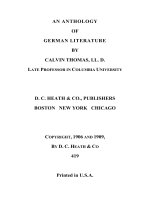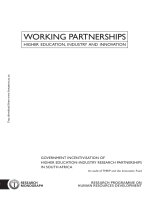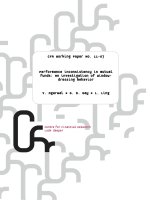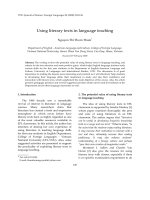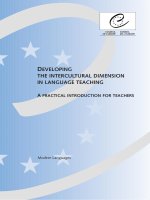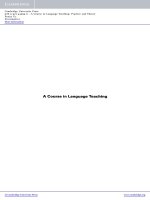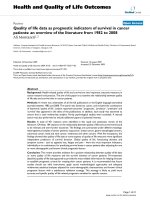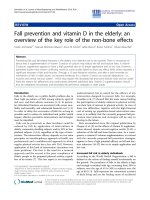Methodology in language teaching an anthology of current practice
Bạn đang xem bản rút gọn của tài liệu. Xem và tải ngay bản đầy đủ của tài liệu tại đây (2.26 MB, 432 trang )
P1: FYX/FYX P2: FYX/UKS QC: FYX/UKS T1: FYX
CY011-FM CY011.cls January 19, 2002 0:35
This page intentionally left blank
P1: FYX/FYX P2: FYX/UKS QC: FYX/UKS T1: FYX
CY011-FM CY011.cls January 19, 2002 0:35
Methodology in
Language Teaching
An Anthology of Current Practice
Edited by
Jack C. Richards
Willy A. Renandya
CAMBRIDGE UNIVERSITY PRESS
Cambridge, New York, Melbourne, Madrid, Cape Town, Singapore, São Paulo
Cambridge University Press
The Edinburgh Building, Cambridge CB2 8RU, UK
First published in print format
ISBN-13 978-0-521-80829-3
ISBN-13 978-0-521-00440-4
ISBN-13 978-0-511-50041-1
© Cambridge University Press 2002
2002
Information on this title: www.cambrid
g
e.or
g
/9780521808293
This publication is in copyright. Subject to statutory exception and to the
provision of relevant collective licensing agreements, no reproduction of any part
may take place without the written permission of Cambridge University Press.
Cambridge University Press has no responsibility for the persistence or accuracy
of urls for external or third-party internet websites referred to in this publication,
and does not guarantee that any content on such websites is, or will remain,
accurate or appropriate.
Published in the United States of America by Cambridge University Press, New York
www.cambridge.org
p
a
p
erback
eBook
(
Adobe Reader
)
hardback
P1: FYX/FYX P2: FYX/UKS QC: FYX/UKS T1: FYX
CY011-FM CY011.cls January 19, 2002 0:35
CONTENTS
Acknowledgments vii
Introduction 1
Section 1 Approaches to Teaching 5
Chapter 1 English Language Teaching in the “Post-Method” Era:
Toward Better Diagnosis, Treatment, and Assessment 9
H. Douglas Brown
Chapter 2 Theories of Teaching in Language Teaching 19
Jack C. Richards
Section 2 Lesson Planning and Classroom Management 27
Chapter 3 Lesson Planning 30
Thomas S. C. Farrell
Chapter 4 Classroom Management 40
Marilyn Lewis
Section 3 Classroom Dynamics 49
Chapter 5 Implementing Cooperative Learning 52
George M. Jacobs and Stephen Hall
Chapter 6 Mixed-Level Teaching: Tiered Tasks and Bias Tasks 59
Bill Bowler and Sue Parminter
Section 4 Syllabus Design and Instructional Materials 65
Chapter 7 The ELT Curriculum: A Flexible Model for a
Changing World 69
Denise Finney
Chapter 8 The Role of Materials in the Language Classroom:
Finding the Balance 80
Jane Crawford
Section 5 Task and Project Work 93
Chapter 9 Implementing Task-Based Language Teaching 96
David Beglar and Alan Hunt
Chapter 10 Project Work: A Means to Promote Language and Content 107
Fredricka L. Stoller
Section 6 Learning Strategies 121
Chapter 11 Language Learning Strategies in a Nutshell: Update and
ESL Suggestions 124
Rebecca L. Oxford
iii
P1: FYX/FYX P2: FYX/UKS QC: FYX/UKS T1: FYX
CY011-FM CY011.cls January 19, 2002 0:35
iv
Contents
Chapter 12 Learner Strategy Training in the Classroom: An Action
Research Study 133
David Nunan
Section 7 Teaching Grammar 145
Chapter 13 Seven Bad Reasons for Teaching Grammar – and Two
Good Ones 148
Michael Swan
Chapter 14 Addressing the Grammar Gap in Task Work 153
Jack C. Richards
Chapter 15 Grammar Teaching – Practice or Consciousness-Raising? 167
Rod Ellis
Section 8 Teaching Pronunciation 175
Chapter 16 Beyond ‘Listen and Repeat’: Pronunciation Teaching
Materials and Theories of Second Language Acquisition 178
Rodney H. Jones
Chapter 17 PracTESOL: It’s Not What You Say, but How You Say It! 188
Julie Hebert
Section 9 Teaching Speaking 201
Chapter 18 Factors to Consider: Developing Adult EFL Students’
Speaking Abilities 204
Kang Shumin
Chapter 19 Conversational English: An Interactive, Collaborative, and
Reflective Approach 212
Wai King Tsang and Matilda Wong
Chapter 20 Developing Discussion Skills in the ESL Classroom 225
Christopher F. Green, Elsie R. Christopher,
and Jacqueline Lam
Section 10 Teaching Listening 235
Chapter 21 Listening in Language Learning 238
David Nunan
Chapter 22 The Changing Face of Listening 242
John Field
Chapter 23 Raising Students’ Awareness of the Features of Real-World
Listening Input 248
Wendy Y. K. Lam
Section 11 Teaching Vocabulary 255
Chapter 24 Current Research and Practice in Teaching Vocabulary 258
Alan Hunt and David Beglar
Chapter 25 Best Practice in Vocabulary Teaching and Learning 267
Paul Nation
P1: FYX/FYX P2: FYX/UKS QC: FYX/UKS T1: FYX
CY011-FM CY011.cls January 19, 2002 0:35
v
Contents
Section 12 Teaching Reading 273
Chapter 26 Dilemmas for the Development of Second Language
Reading Abilities 276
William Grabe
Chapter 27 Teaching Strategic Reading 287
Joy Janzen
Chapter 28 Extensive Reading: Why Aren’t We All Doing It? 295
Willy A. Renandya and George M. Jacobs
Section 13 Teaching Writing 303
Chapter 29 Ten Steps in Planning a Writing Course and Training
Teachers of Writing 306
Ann Raimes
Chapter 30 The Writing Process and Process Writing 315
Anthony Seow
Chapter 31 A Genre-Based Approach to Content Writing Instruction 321
Randi Reppen
Chapter 32 Teaching Students to Self-Edit 328
Dana Ferris
Section 14 Assessment 335
Chapter 33 Alternative Assessment: Responses to Commonly
Asked Questions 338
Ana Huerta-Mac
´
ıas
Chapter 34 Nontraditional Forms of Assessment and Response to
Student Writing: A Step Toward Learner Autonomy 344
Andrea H. Pe
˜
naflorida
Chapter 35 English Proficiency Test: The Oral Component of a
Primary School 354
Ishbel Hingle and Viv Linington
Section 15 Technologies in the Classroom 361
Chapter 36 Video in the ELT Classroom: The Role of the Teacher 364
Susan Stempleski
Chapter 37 The Internet for English Teaching: Guidelines for Teachers 368
Mark Warschauer and P. Fawn Whittaker
Chapter 38 What Can the World Wide Web Offer ESL Teachers? 374
Rong-Chang Li and Robert S. Hart
Section 16 Professional Development 385
Chapter 39 The English Teacher as Professional 388
Penny Ur
Chapter 40 Developing Our Professional Competence:
Some Reflections 393
Joanne Pettis
P1: FYX/FYX P2: FYX/UKS QC: FYX/UKS T1: FYX
CY011-FM CY011.cls January 19, 2002 0:35
vi
Contents
Chapter 41 Research in Your Own Classroom 397
Elizabeth Taylor
Credits 405
Author Index 409
Subject Index 415
P1: FYX/FYX P2: FYX/UKS QC: FYX/UKS T1: FYX
CY011-FM CY011.cls January 19, 2002 0:35
ACKNOWLEDGMENTS
We are grateful to the contributors to this volume for allowing us to include their
papers in this anthology. All royalties generated from the sale of this book payable to
the editors and to the contributors are being donated to the South East Asian Ministers
of Education Organization (SEAMEO) Regional Language Centre (RELC), Singapore, to
support scholarships for English language teachers from SEAMEO member countries to
attend in-service courses offered at RELC.
vii
P1: FYX/FYX P2: FYX/UKS QC: FYX/UKS T1: FYX
CY011-FM CY011.cls January 19, 2002 0:35
0521808294int CY011.cls December 3, 2001 14:32
Introduction
This book seeks to provide an overview of current approaches, issues, and practices in the
teaching of English to speakers of other languages (TESOL). It has the following goals:
r
to provide a comprehensive overview of the field of second and foreign
language teaching, with a particular focus on issues related to the teaching of
English
r
to provide a source of teaching principles and classroom activities which
teachers can refer to in their work
r
to provide a source of readings and activities that can be used in TESOL
teacher-education programs, for both preservice and in-service courses
The articles in this anthology offer a comprehensive picture of approaches to the teach-
ing of English and illustrate the complexity underlying many of the practical planning and
instructional activities it involves. These activities include teaching English at elementary,
secondary, and tertiary levels, teacher training, language testing, curriculum and materials
development, the use of computers and other technology in teaching, as well as research on
different aspects of second language learning. The issues that form the focus of attention in
TESOL around the world reflect the contexts in which English is taught and used. English
in different parts of the world where it is not a native language may have the status of either
a “second” or a “foreign” language. In the former case, it is a language that is widely used
in society and learners need to acquire English in order to survive in society. In the latter
case, it may be taught as a school subject but has restricted uses in society at large. Learners
of English may be studying American, Canadian, Australian, British, or some other variety
of English. They may be learning it for educational, occupational, or social purposes. They
may be in a formal classroom setting or studying independently, using a variety of media
and resources. The teachers of English may be native speakers of English or those for whom
it is a second or foreign language.
1
0521808294int CY011.cls December 3, 2001 14:32
2
Methodology in Language Teaching
The issues seen to be important at any particular point in time and the approaches to
teaching that are followed in different parts of the world reflect contextual factors such as
those just mentioned, current understanding of the nature of second language learning, edu-
cational trends and practices in different parts of the world, and the priorities the profession
accords to specific issues and practices. In the last 30 years or so, the field of Teaching
English as a Second or Foreign Language has developed into a dynamic worldwide com-
munity of language teaching professionals that seeks to improve the quality of language
teaching and learning through addressing the key issues that shape the design and delivery
of language teaching. These issues center on
r
understanding learners and their roles, rights, needs, motivations, strategies,
and the processes they employ in second language learning
r
understanding the nature of language teaching and learning and the roles
teachers, teaching methods, and teaching materials play in facilitating
successful learning
r
understanding how English functions in the lives of learners, the way the
English language works, the particular difficulties it poses for second
language learners, and how learners can best achieve their goals in learning
English
r
understanding how schools, classrooms, communities, and the language
teaching profession can best support the teaching and learning of English
It is this view of teaching that has guided the selection of articles for this anthology. The
anthology brings together articles which have been published in journals in many different
parts of the world but which deal with issues that are of importance no matter where English
is being taught. (Only three articles in the collection – those by Farrell, Lewis, and Renandya
and Jacobs – have not been published previously.) The goal of the collection is to bring
together in one volume articles which treat the range of issues normally included in TESOL
methodology courses. We have sought to include only recent articles or articles that present
perspectives that are still current. Most of the articles in the collection, therefore, have been
published within the last 5 years. Nearly 70% of the articles have been published since
1996, and of the rest, none was published before 1992. The following topics are included:
r
the nature of teaching – methods, teaching skills
r
classroom interaction and management – lesson planning, grouping,
classroom dynamics
r
teaching the skills – reading, writing, listening, speaking
r
understanding learner variables – learning strategies, motivation, age
r
addressing linguistic competence – grammar, vocabulary, and pronunciation
r
curriculum factors – syllabus design, materials development
r
assessment of learning – alternative assessment, proficiency tests
r
the role of technology – video, computers, the Internet
r
teacher development – evaluating teaching, classroom research, action
research
The book is organized into sixteen sections that reflect these topics. Each section
includes a balance of articles that address both theory and practice. Key issues in relevant
theory and research are presented. At the same time, classroom practitioners show not only
how theory can inform classroom practice, but also how the practical realities of teaching
can inform theory and research.
Two sets of discussion questions are included. One set serves as prereading questions
and seeks to explore some of the background knowledge, beliefs, and practical experience
0521808294int CY011.cls December 3, 2001 14:32
3
Introduction
that student teachers and teachers in training possess and that can provide a source of
reference when reading each article. The second set of questions is designed to be used
after the section has been read and seeks to engage the readers in critical reflection on the
issues discussed, as well as to provide application to teaching practice. We hope that student
teachers, teachers, and teacher educators will find the collection a useful resource for the
understanding of current approaches and practices in the teaching of English as a second
or foreign language.
0521808294int CY011.cls December 3, 2001 14:32
0521808294p01 CY011.cls January 21, 2002 16:25
SECTION
1
APPROACHES TO TEACHING
INTRODUCTION
The two papers in this section reexamine the notion of methods of teaching and offer
complementary perspectives on how the nature of teaching can be understood. Although
for much of the twentieth century a primary concern of the language teaching profession
was to find more effective methods of language teaching, by the twenty-first century there
has been a movement away from a preoccupation with generic teaching methods toward a
more complex view of language teaching which encompasses a multifaceted understanding
of the teaching and learning processes. Brown traces this movement from a preoccupation
with “methods” to a focus on “pedagogy.”
The notion of teaching methods has had a long history in language teaching, as is
witnessed by the rise and fall of a variety of methods throughout the recent history of
language teaching. Some, such as Audiolingualism, became the orthodox teaching methods
of the 1970s in many parts of the world. Other guru-led methods such as the Silent Way
attracted small but devoted followers in the 1980s and beyond, but attract little attention
today. Many teachers have found the notion of methods attractive over the last one hundred
or so years, since they offer apparently foolproof systems for classroom instruction and
are hence sometimes embraced enthusiastically as a panacea for the “language teaching
problem.” The 1970s and 1980s were perhaps the years of greatest enthusiasm for methods.
In what has been called the “post-methods era,” attention has shifted to teaching and learning
processes and the contributions of the individual teacher to language teaching pedagogy.
Brown discusses a number of reasons for the decline of the methods syndrome in
contemporary discussions of language teaching. As he and others have commented, the
5
0521808294p01 CY011.cls January 21, 2002 16:25
6
Approaches to Teaching
notion of all-purpose “designer methods” that will work anywhere and for everyone raises
a number of problems:
r
Methods are typically top-down impositions of experts’ views of teaching.
The role of the individual teacher is minimized. His or her role is to apply the
method and adapt his or her teaching style to make it conform to the method.
Methods are hence prescriptive.
r
Methods fail to address the broader contexts of teaching and learning and
focus on only one small part of a more complex set of elements. Brown
describes what may be called a “curriculum development” approach to
teaching, which begins with diagnosis (i.e., needs analysis, syllabus, and
materials development), then moves to treatment (i.e., instruction and
pedagogy), and involves issues of assessment (i.e., testing and evaluation).
For Brown, the term method is best replaced by the term pedagogy. The former implies
a static set of procedures, whereasthelattersuggests the dynamic interplay between teachers,
learners, and instructional materials during the process of teaching and learning. Brown
characterizes the basis of language teaching pedagogy in terms of twelve principles that
reflect current research and theory about second language acquisition.
Richards seeks to show how three different conceptions of teaching in the recent his-
tory of language teaching have led to different understandings of the essential skills of
teachers and to different approaches to teacher training and teacher development. Science-
research conceptions of teaching seek to develop teaching methods from applications of
research, and see improvements in teaching as dependent on research into learning, mo-
tivation, memory, and related factors. Good teaching is a question of applying the find-
ings of research. Task-Based Language Teaching and attempts to apply brain research to
teaching are current examples of this approach. Theory-philosophy conceptions of teaching
derive from rational “commonsense” understandings of teaching or from one’s ideology
or value system, rather than from research. Communicative Language Teaching (CLT) is
a good example of this approach, since it is based on an ideology rather than a research
agenda, as are such movements as Critical Theory and Critical Pedagogy. Advocates of
these movements see their mission as to convince teachers of the correctness of the the-
ory, to review their teaching to see to what extent it matches their values, and to seek to
incorporate the relevant principles or values into their teaching. Art-craft conceptions of
teaching, by comparison, see good teaching as something unique and personal to teachers.
A teaching theory is viewed as something that is constructed by individual teachers. From
this perspective, teaching is viewed as driven by teachers’ attempts to integrate theory and
practice. Teacher-education programs give teachers a grounding in academic theory and
research, which they test out against the practical realities of teaching. In so doing, they
create their own new understandings of teaching, which are expanded and revised as they
tackle new problems and deepen their experiential and knowledge base of teaching.
Many of the issues highlighted in this section will reappear throughout this collection
of papers. In many of the papers, the writers describe approaches to teaching which are
informed by educational theory and practice and exemplify many of the issues Brown
touches on in his paper, as well as one or another of the conceptions of teaching described
by Richards. At the same time, many of the papers illustrate the personal and unique
solutions to problems and issues that individual teachers or groups of teachers often find in
their teaching, demonstrating that for many teachers the day-to-day process of teaching is
a kind of ongoing research and experimentation.
0521808294p01 CY011.cls January 21, 2002 16:25
7
Introduction
DISCUSSION
QUESTIONS
Before Reading
1. What experience do you have of learning a second or foreign language? How would
you characterize the teacher’s teaching method? How effective did you find it?
2. What do you understand by a teaching “method” and what is the source of different
methods? How do methods often differ from one another?
3. Is your teaching based on a particular method of teaching? If so, how did you learn to
teach in this way?
4. Do you agree that the notion of “method” presents a restrictive view of the nature of
teaching? When might it be useful to teach according to a specific method?
5. How do you understand the differences between an “approach” and a “method”?Is
this a useful distinction?
6. Why do you think many teachers are attracted to the idea of “a best method”?
7. What are the three most important principles that you think a teacher has to be aware
of in teaching an ESL class? Where do these (and other principles) come from?
8. Some learners appear to be more effective language learners than others because they
use more effective learning strategies. What do you understand by a “learning
strategy”? Can you give examples of strategies that successful learners might use?
9. How important do you think risk taking is in language learning?
10. What role do you think motivation plays in learning a language? How can learner
motivation be developed?
11. Which of these words do you think can be used to describe teaching? What view of
teaching do these terms suggest to you: a science, a profession, an art, a craft, a
technology, an industry?
12. What role does theory play in shaping teaching practice? Is good practice dependent
on theory?
After Reading
1. Examine the twelve principles proposed by Brown. Do some of them seem more
important than others? Are there any you would wish to add or delete?
2. How can teachers gather and make use of the kind of information Brown discusses
under “diagnosis”?
3. Examine the suggestions Brown gives for developing “strategic investment.” Can you
suggest other activities that address each of the ten principles Brown discusses?
4. Select a group of learners you are familiar with. What do you think are their primary
motivations for learning English? In what ways can learner motivations be explored
and addressed in a language program?
5. Reflect on your own experiences as a language learner. To what extent were you
taught strategies for language learning? Did you develop independently an awareness
of the importance of strategies? What examples can you give?
6. What do you think is the role of research in improving our understanding of teaching?
7. How do you think teachers develop their ideas about teaching? What sources do you
think shape their beliefs and practice?
0521808294p01 CY011.cls January 21, 2002 16:25
8
Approaches to Teaching
8. What do you think are the most essential skills of a good language teacher? What is
the source of your ideas about the nature of teaching skills?
9. Describe your personal philosophy of teaching and some of the key beliefs about
teachers, learners, and teaching that influence your approach to teaching. How would
this philosophy be evident to someone observing you teaching a class?
10. How do you think teachers change their approach to teaching over time? What do you
think are some of the differences between a novice teacher and an expert teacher?
How can teachers with different levels of experience learn from each other?
0521808294c01 CY011.cls January 18, 2002 0:53
CHAPTER
1
English Language Teaching in the
“Post-Method” Era: Toward Better
Diagnosis, Treatment, and Assessment
H. Douglas Brown
INTRODUCTION
In the century spanning the mid-1880s to the mid-1980s, the language teaching profession
was involved in what many pedagogical experts would call a search. That search was for a
single, ideal method, generalizable across widely varying audiences, that would successfully
teach students a foreign language in the classroom. Historical accounts of the profession
tend, therefore, to describe a succession of methods, each of which is more or less discarded
in due course as a new method takes its place. I will comment on “the changing winds and
shifting sands” (Marckwardt, 1972, p. 5) of that history momentarily; but first, we should
try to understand what we mean by method.
What is a method? More than three decades ago, Edward Anthony (1963) gave us
a definition that has quite admirably withstood the test of time. His concept of method
was the second of three hierarchical elements, namely, approach, method, and technique.
An approach, according to Anthony, was a set of assumptions dealing with the nature of
language, learning, and teaching. Method was defined as an overall plan for systematic
presentation of language based on a selected approach. It followed that techniques were
specific classroom activities consistent with a method, and therefore in harmony with an
approach as well.
Some disagreement over Anthony’s definition can occasionally be found in the litera-
ture. For Richards and Rodgers (1986), method was an umbrella term to capture redefined
approaches, designs, and procedures. Similarly, Prabhu (1990) thought of method as both
classroom activities and the theory that informs them. Despite these and a handful of other
attempted redefinitions (see Pennycook, 1989), we still commonly refer to methods in
terms of Anthony’s earlier understanding. For most researchers and practicing teachers,
a method is a set of theoretically unified classroom techniques thought to be generaliz-
able across a wide variety of contexts and audiences. Thus, for example, we speak of the
9
0521808294c01 CY011.cls January 18, 2002 0:53
10
H. Douglas Brown
Audiolingual Method, the Direct Method, and of the Silent Way or Suggestopedia, all as
methods.
METHODS:ACENTURY-OLD OBSESSION
Ironically, the whole concept of separate methods is no longer a central issue in language
teaching practice (see Kumaravadivelu, 1994, among others). In fact, in the mid-1980s, H. H.
Stern (1985, p. 251) lamented our “century-old obsession,” our “prolonged preoccupation
[with methods] that has been increasingly unproductive and misguided,” as we vainly
searched for the ultimate method that would serve as the final answer.
That search might be said to have begun around 1880 with Fran¸cois Gouin’s pub-
lication of The Art of Teaching and Learning Foreign Languages (1880), in which his
Series Method was advocated. This was followed at the turn of the century by the Direct
Method of Charles Berlitz. The Audiolingual Method of the late 1940s and the so-called
Cognitive-Code Learning Method of the early 1960s followed. Then, in a burst of inno-
vation, the “spirited seventies,” as I like to refer to them, brought us what David Nunan
(1989) termed the “designer” methods: Community Language Learning, the Silent Way,
Suggestopedia, Total Physical Response, and others. This latter flurry was not unlike an
earlier period in the field of psychotherapy which burgeoned with a plethora of “methods”
of therapy; some of the “designer” terms of that era were T group, encounter group, analyt-
ical, Gestalt, marathon group, conjoint family, shock, client-centered, and narcosis therapy,
electro-narcosis, biochemotherapy, and analytic psychobiology!
Why are methods no longer the milestones of our language teaching journey through
time? Our requiem for methods might list four possible causes of demise:
1. Methods are too prescriptive, assuming too much about a context before the context
has even been identified. They are therefore overgeneralized in their potential
application to practical situations.
2. Generally, methods are quite distinctive at the early, beginning stages of a language
course and rather indistinguishable from each other at later stages. In the first few
days of a Community Language Learning class, for example, the students witness a
unique set of experiences in their small circles of translated language whispered in
their ears. But, within a matter of weeks, such classrooms can look like any other
learner-centered curriculum.
3. It was once thought that methods could be empirically tested by scientific
quantification to determine which one is “best.” We have now discovered that
something as artful and intuitive as language pedagogy cannot ever be so clearly
verified by empirical validation.
4. Methods are laden with what Pennycook (1989) referred to as “interested
knowledge”–the quasi-political or mercenary agendas of their proponents. Recent
work in the power and politics of English language teaching (see, especially,
Pennycook, 1994; Tollefson, 1995; and Holliday, 1994) has demonstrated that
methods, often the creations of the powerful “center,” become vehicles of a
“linguistic imperialism” (Phillipson, 1992) targeting the disempowered
periphery.
David Nunan (1991, p. 228) summed it up nicely:
It has been realised that there never was and probably never will be a me-
thod for all, and the focus in recent years has been on the development of
0521808294c01 CY011.cls January 18, 2002 0:53
11
English Language Teaching in the “Post-Method” Era
classroom tasks and activities which are consonant with what we know
about second language acquisition, and which are also in keeping with the
dynamics of the classroom itself.
APRINCIPLED APPROACH
And so, as we lay to rest the methods that have become so familiar to us in recent decades,
what assurance do we have today of the viability of our language teaching profession?
Through the 1970s and into the early 1980s, there was a good deal of hoopla about the
“designer” methods. Even though they were not widely adopted standards of practice, they
were nevertheless symbolic of a profession at least partially caught up in a mad scramble
to invent a new method when the very concept of method was eroding under our feet. We
did not need a new method. We needed, instead, to get on with the business of unifying our
approach
1
to language teaching and of designing effective tasks and techniques informed
by that approach.
By the end of the 1980s, such an approach was clearly becoming evident in teaching
practices worldwide. We had learned some profound lessons from our past wanderings. We
had learned to make enlightened choices of teaching practices that were solidly grounded
in the best of what we knew about second language learning and teaching. We had amassed
enough research on learning and teaching in a multiplicity of contexts that we were indeed
formulating an integrated approach to language pedagogy. Of course, we had not attained a
theoretical mountaintop by any means; much remained – and still remains – to be questioned
and investigated.
It should be clear from the foregoing that, as “enlightened” teachers, we can think in
terms of a number of possible methodological – or, shall we say, pedagogical – options
at our disposal for tailoring classes to particular contexts. Our approach – or theory of
language and language learning – therefore takes on great importance. One’s approach to
language teaching is the theoretical rationale that underlies everything that happens in the
classroom. It is the cumulative body of knowledge and principles that enables teachers, as
“technicians” in the classroom, to diagnose the needs of students, to treat students with
successful pedagogical techniques, and to assess the outcome of those treatments.
An approach to language pedagogy is not just a set of static principles “set in stone.” It
is, in fact, a dynamic composite of energies within a teacher that changes (or should change,
if one is a growing teacher) with continued experience in learning and teaching. There is
far too much that we do not know collectively about this process, and there are far too many
new research findings pouring in, to assume that a teacher can confidently assert that he or
she knows everything that needs to be known about language and language learning.
One teacher’s approach may, of course, differ on various issues from that of a colleague,
or even of “experts” in the field, who differ among themselves. There are two reasons for
variation at the approach level: (1) an approach is by definition dynamic and therefore
subject to some “tinkering” as a result of one’s observation and experience; and (2) research
in second language acquisition and pedagogy almost always yields findings that are subject
to interpretation rather than giving conclusive evidence.
The interaction between one’s approach and classroom practice is the key to dynamic
teaching. The best teachers are able to take calculated risks in the classroom: as new student
needs are perceived, innovative pedagogical techniques are attempted, and the follow-up
assessment yields an observed judgment on their effectiveness. Initial inspiration for such
innovation comes from the approach level, but the feedback that teachers gather from actual
implementation then reshapes and modifies their overall understanding of what learning
and teaching are – which, in turn, may give rise to a new insight and more innovative
possibilities, and the cycle continues.
0521808294c01 CY011.cls January 18, 2002 0:53
12
H. Douglas Brown
TWELVE PRINCIPLES
I would like to suggest that viable current approaches to language teaching are “principled,”
in that there is perhaps a finite number of general research-based principles on which
classroom practice is grounded. The twelve principles that I list and define in this section (see
Brown, 1994a, for a complete discussion with definitions and examples) are an inexhaustive
number of what I would assert to be relatively widely accepted thoretical assumptions about
second language acquisition. There is sometimes disagreement in their interpretation and
their application in the classroom, but they nevertheless comprise a body of constructs
which few would dispute as central to most language acquisition contexts. They are briefly
summarized here.
1. AUTOMATICITY
Efficient second language learning involves a timely movement of the control of a few
language forms into the automatic processing of a relatively unlimited number of language
forms. Overanalyzing language, thinking too much about its forms, and consciously linger-
ing on rules of language all tend to impede this graduation to automaticity.
2.
MEANINGFUL LEARNING
Meaningful learning will lead toward better long-term retention than rote learning. One
among many examples of meaningful learning is found in content-centered approaches to
language teaching.
3. THE ANTICIPATION OF REWARD
Human beings are universally driven to act, or “behave,” by the anticipation of some sort of
reward – tangible or intangible, short-term or long-term – that will ensue as a result of the
behavior. Although long-term success in language learning requires a more intrinsic motive
(see 4 below), the power of immediate rewards in a language class is undeniable. One of
the tasks of the teacher is to create opportunities for those moment-by-moment rewards that
can keep classrooms interesting, if not exciting.
4. INTRINSIC MOTIVATION
Sometimes, reward-driven behavior is dependent on extrinsic (externally administered by
someone else) motivation. But a more powerful category of reward is one which is intrinsi-
cally driven within the learner. When behavior stems from needs, wants, or desires within
oneself, the behavior itself has the potential to be self-rewarding. In such a context, exter-
nally administered rewards are unnecessary; learners are likely to maintain the behavior
beyond the immediate presence of teachers, parents, and other tutors.
5. STRATEGIC INVESTMENT
Successful mastery of the second language will be, to a large extent, the result of a
learner’s own personal “investment” of time, effort, and attention to the second language
in the form of an individualized battery of strategies for comprehending and producing the
language.
6. LANGUAGE EGO
As human beings learn to use a second language, they develop a new mode of thinking,
feeling, and acting – a second identity. The new “language ego,” intertwined with the second
language, can easily create within the learner a sense of fragility, defensiveness, and a raising
of inhibitions.
0521808294c01 CY011.cls January 18, 2002 0:53
13
English Language Teaching in the “Post-Method” Era
7.
SELF
-CONFIDENCE
The eventual success that learners attain in a task is partially a factor of their belief that they
indeed are fully capable of accomplishing the task. Self-esteem, at least global self-esteem,
lies at the roots of eventual attainment.
8. RISK TAKING
Successful language learners, in their realistic appraisal of themselves as vulnerable beings
yet capable of accomplishing tasks, must be willing to become “gamblers” in the game of
language, to attempt to produce and to interpret language that is a bit beyond their absolute
certainty.
9. THE LANGUAGE
–CULTURE CONNECTION
Whenever you teach a language, you also teach a complex system of cultural customs,
values, and ways of thinking, feeling, and acting.
10.
THE NATIVE LANGUAGE EFFECT
The native language of learners will be a highly significant system on which learners
will rely to predict the target-language system. Although that native system will exercise
both facilitating and interfering (positive and negative transfer) effects on the production
and comprehension of the new language, the interfering effects are likely to be the most
salient.
11. INTERLANGUAGE
Second language learners tend to go through a systematic or quasi-systematic developmental
process as they progress to full competence in the target language. Successful interlanguage
development is partially a factor of utilizing feedback from others. Teachers in language
classrooms can provide such feedback, but more important, can help learners to generate
their own feedback outside of the language classroom.
12. COMMUNICATIVE COMPETENCE
Given that communicative competence is the goal of a language classroom, instruction
needs to point toward all of its components: organizational, pragmatic, strategic, and psy-
chomotoric. Communicative goals are best achieved by giving due attention to language use
and not just usage, to fluency and not just accuracy, to authentic language and contexts, and
to students’ eventual need to apply classroom learning to heretofore unrehearsed contexts
in the real world.
DIAGNOSIS,TREATMENT, AND ASSESSMENT
A principled approach to language teaching encourages the language teacher to engage in
a carefully crafted process of diagnosis, treatment, and assessment. It enables us initially
to account for communicative and situational needs anticipated among designated learners,
and to diagnose appropriate curricular treatment for those specific learners in their distinc-
tive context and for their particular goals. It helps us then to devise effective pedagogical
objectives which have taken into account all the contextual variables in a classroom. A
sound, comprehensive approach underlies the creation of a set of learning experiences that
are appropriate, given specific contexts and purposes, for realizing established objectives.
It enables teachers to assess what went right and what went wrong in a lesson, that is, to
systematically evaluate the accomplishment of curricular objectives. And it assists them in
revising activities, lessons, materials, and curricula.
0521808294c01 CY011.cls January 18, 2002 0:53
14
H. Douglas Brown
DIAGNOSIS
The first phase of the diagnostic stage of language pedagogy begins with curricular plans and
continues as an ongoing monitoring process in the classroom. Language curricula call for an
initial study of what Richards (1990) calls “situational” needs, or the context of the teaching.
Situational needs include consideration of the country of the institution, the socioeconomic
and educational background of the students, the specific purposes the students have in
learning a language, and institutional constraints that are imposed on a curriculum. Some
of the twelve principles cited earlier come into play in isolating situational needs:
r
Is language proficiency perceived by students as intrinsically motivating?
r
To what extent will the language in question involve students in wrestling
with a “new identity” and therefore imply a language ego issue?
r
What is the relationship between the target language and the native culture of
the students?
A host of other educational, sociological, and administrative principles come to bear in
specifying situational needs; these are but a few.
The second phase of curricular development is typified by the specification of
linguistic – sometimes called “communicative”–needs: the specific language forms and
functions that should be programmed into a course of study. Here again, certain principles
of learning and teaching inform our choices:
r
To what extent are native-language and target-language contrasts important
to consider?
r
How should interlanguage systematicity and variation affect curriculum
designs?
r
What do studies of contrastive analysis, interlanguage, and communicative
competence tell us about the sequencing of linguistic forms and functions in
a curriculum?
r
How can the curriculum realize the principle of authenticity?
Of equal importance in the planning stages of language courses is the specific diagnos-
tic assessment of each student upon entering a program. Once courses have been carefully
planned, with pedagogical options intricately woven in, how can teachers and/or adminis-
trators become diagnostic scientists and artists, carefully eliciting language production and
comprehension on the part of every student? How should those elicitations be measured
and assessed in such a way that the language course can be either slightly or greatly mod-
ified to meet the needs of the particular students who happen to be in one’s class at this
moment?
None of these complex questions can be answered with the language teaching profes-
sion’s recently interred methods! The crucial import of the diagnostic phase of language
courses precludes any consideration of methods that are prepackaged for delivery to all
learners. One of the principal fields of inquiry in the profession today is this very stage
of diagnosis, that of more adequately pinpointing learners’ linguistic needs as they enter a
program of study.
TREATMENT
One may be tempted to think of “treatment” as the appropriate stage for the application of
methods. One can still find people arguing, for example, that if a diagnostic phase discovered
learners who need a great deal of physical activity, little metalinguistic explanation, and
a strongly directive teacher, then surely Total Physical Response (TPR) is the treatment
0521808294c01 CY011.cls January 18, 2002 0:53
15
English Language Teaching in the “Post-Method” Era
that should be offered. The problem with this conclusion is that it is over-generalized and
much too restrictive. Certain learners can indeed benefit from occasional doses of “TPR-
like” techniques, but certainly the complexity of the second language acquisition process
warrants a multiple-treatment, multiphase approach to a language course. The principles
that collectively underlie the method as we knew them provide a few valid correlates of an
approach to diagnosis and treatment, but a single method covers far too narrow a band of
possibilities to suffice for a whole curriculum.
Second language “treatments” may be thought of as courses of study or, better, sets of
learning experiences, designed to target learner needs exposed by diagnostic assessments.
For such treatments, the profession offers an extraordinarily large number of options. Con-
sider, just as a start, the thirty-eight language teaching techniques categorized by Crookes
and Chaudron (1991, pp. 52–54), ranging from controlled (drills, dialogues, reading aloud,
display questions/answers, etc.) to semicontrolled (referential questions/answers, cued nar-
ratives, information gap activities, etc.) to free (role-plays, problem solving, interviews,
discussions, etc.). Consider as well an abundance of whole-class, group-work, and pair-
work activities at our disposal. Then, just take a look at the mountain of textbooks and other
materials represented at a major language teaching conference! It is the teacher’s task to
carefully and deliberately choose among these many options to formulate a pedagogical
sequence of techniques in the classroom. And this is where a teacher’s choices must be
“principled.”
One way of looking at principled choices for treatment is the extent to which a technique
promotes a desired goal. For example, let’s suppose a teacher wishes to deliver techniques
that seek to create intrinsic motivation in learners. The principle of intrinsic motivation
implies more than a few corollaries that can act as a “test” of a technique’s potential for
creating or sustaining intrinsic motivation (see Brown 1994b, pp.33–46, for a full develop-
ment of intrinsic motivation in the classroom). Consider the following checklist, each item
of which represents a facet of the principle of intrinsic motivation:
1. Does the technique appeal to the genuine interests of your students? Is it relevant to
their lives?
2. Is the technique presented in a positive, enthusiastic manner?
3. Are students clearly aware of the purpose of the technique?
4. Do students have some choice in: (a) choosing some aspect of the technique? and/or
(b) determining how they go about fulfilling the goals of the technique?
5. Does the technique encourage students to discover for themselves certain principles
or rules (rather than simply being “told”)?
6. Does it encourage students in some way to develop or use effective strategies of
learning and communication?
7. Does it contribute – at least to some extent – to students’ ultimate autonomy and
independence (from you)?
8. Does it foster cooperative negotiation with other students in the class? Is it a truly
interactive technique?
9. Does the technique present a “reasonable challenge”?
10. Do students receive sufficient feedback on their performance (from each other or
from you)?
By the careful delivery of techniques that incorporate many of these criteria, teachers
can be more assured of offering treatments that are specifically designed to accomplish the
goal of fostering intrinsic motivation. This is a far more sophisticated and effective option
